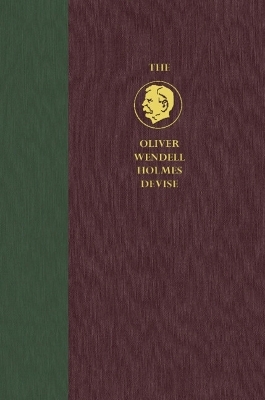
The Taft Court 2 Volume Hardback Set: Volume 10
Cambridge University Press
978-1-009-33621-5 (ISBN)
The Taft Court offers the definitive history of the Supreme Court from 1921 to 1930 when William Howard Taft was Chief Justice. Using untapped archival material, Robert C. Post engagingly recounts the ambivalent effort to create a modern American administrative state out of the institutional innovations of World War I. He shows how the Court sought to establish authoritative forms of constitutional interpretation despite the culture wars that enveloped prohibition and pervasive labor unrest. He explores in great detail how constitutional law responds to altered circumstances. The work provides comprehensive portraits of seminal figures such as Oliver Wendell Holmes Jr. and Louis Dembitz Brandeis. It describes William Howard Taft's many judicial reforms and his profound alteration of the role of Chief Justice. A critical and timely contribution, The Taft Court sheds light on jurisprudential debates that are just as relevant today as they were a century ago.
Robert C. Post is the Sterling Professor of Law at Yale Law School. He served as the sixteenth Dean of Yale Law School from 2009 to 2017. He specializes in constitutional law, with particular emphasis on the First Amendment. His book For the Common Good: Principles of American Academic Freedom (with Matthew W. Finkin) has become the standard reference text for the meaning of academic freedom in the United States.
Prologue Mr. Taft Takes Charge; Part I: Constructing the Taft Court: Appointments; 1. John Hessin Clarke and George Sutherland; 2. William Rufus Day and Pierce Butler; 3. Mahlon Pitney and Edward Terry Sanford; 4. Joseph McKenna and Harlan Fiske Stone; Part II: The Holdover Justices; 5. Oliver Wendell Holmes; 6. Willis Van Devanter; 7. James Clark McReynolds; 8. Louis Dembitz Brandeis; Part III: The Incomparable Chief Justiceship of William Howard Taft; 9. Taft's Health; 10. Taft as a Justice; 11. Myers v. United States; 12.The Conference of Senior Circuit Court Judges; 13. Reshaping the Supreme Court; 14. The Changing Role of Chief Justice; 15. The Chief Justice as Chancellor; 16. Lobbying for Judicial Appointments; 17. Creating a New Supreme Court Building; Part IV: The Taft Court as an Institution; 18. Judicial Opinions during the Taft Court; 19. Dissent during the Taft Court; 20. The Authority of the Taft Court; Part V: Social and Economic Legislation; 21. 'Everything Is on Edge': World War I and the American State; 22. Cabining the Constitutional Implications of the War; 23. Diminishing Judicial Deference; 24. Adkins v. Children's Hospital; 25. Price Fixing and Property Affected with a Public Interest; 26. The Protected Realm of Freedom; 27. Ratemaking and Judicial Legitimacy; Part VI: The Positive Law of Prohibition; 28. Prohibition, the Taft Court, and the Authority of Law; 29. Prohibition and Dual Sovereignty; 30. Prohibition and Normative Dualism; 31. Prohibition and Positive Law; 32. Prohibition and Law Enforcement; 33. Olmstead v. United States; Part VII: Federalism and the American People; 34. Federalism and World War I; 35. Dual Sovereignty and Intergovernmental Tax Immunities; 36. Normative Dualism and Congressional Power; 37. The Dormant Commerce Clause and the National Market; 38. National Judicial Power and the American People; Part VIII: Labor, Equal Protection, and Race; 39. Labor and the Jurisprudence of Individualism; 40. Labor and the Construction of the National Market; 41. Government by Injunction; 42. Truax v. Corrigan; 43. The Equal Protection Clause and Race; Epilogue Chief Justice Taft Exits the Scene.
| Erscheint lt. Verlag | 9.11.2023 |
|---|---|
| Reihe/Serie | Oliver Wendell Holmes Devise History of the Supreme Court of the United States |
| Zusatzinfo | Worked examples or Exercises |
| Verlagsort | Cambridge |
| Sprache | englisch |
| Maße | 161 x 241 mm |
| Gewicht | 3070 g |
| Themenwelt | Geisteswissenschaften ► Geschichte ► Regional- / Ländergeschichte |
| Geschichte ► Teilgebiete der Geschichte ► Militärgeschichte | |
| Recht / Steuern ► Allgemeines / Lexika | |
| Recht / Steuern ► EU / Internationales Recht | |
| Recht / Steuern ► Rechtsgeschichte | |
| ISBN-10 | 1-009-33621-5 / 1009336215 |
| ISBN-13 | 978-1-009-33621-5 / 9781009336215 |
| Zustand | Neuware |
| Haben Sie eine Frage zum Produkt? |